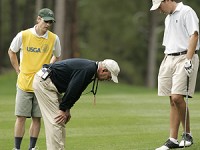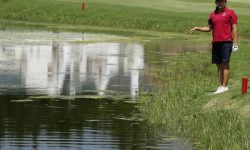Written By: Nick Heyrman | @NCCGATourneys
With the NCCGA season upon us, it is a great time to test your knowledge of the rules of golf. We've all seen many of these rules come up during a round, either to you personally or to a playing partner. And while we may all think we know the right answers, do you really?
I’ve devised a 10 question rules test to assess your knowledge of some common situations that may occur on the course. Test your knowledge and see who can do the best from your club team. Let us know how you score by sending me a tweet @NCCGATourneys!
Assume individual stroke play is the format for each question.
Q1) How many relief options do you have for a lateral water hazard (red stakes and lines)?
- 3
- 5
- 4
- 2
Q2) True or False: You are entitled to free relief from a boundary fence that marks the out-of-bounds line.
- True
- False
Q3) True or False: If you knock your ball off of the tee without the intent to make a stroke at the ball, you are allowed to replace the ball on the tee.
- True
- False
Q4) What is the penalty for hitting your partner’s golf bag with your ball?
- 1 stroke and play the ball from where it ends up
- 2 strokes and play the ball from where it ends up
- No penalty, play the ball from where it ends up
- No penalty, replay shot
Q5) True or False: One of your relief options from a water hazard (yellow stakes and lines) is dropping a ball within two club-lengths of where your ball last crossed the margin of the hazard.
- True
- False
Q6) What is the penalty for a player if he accidentally moves his ball while probing the water for it in a water hazard?
- 1 stroke
- 2 strokes
- No penalty, replace the ball
Q7) True or False: You must re-drop the ball if it rolls out more than two club-lengths from the place it first hit the course or if it comes to rest nearer the hole than the nearest point of relief.
- True
- False
Q8) True or False: Any loose impediment may be removed without penalty except for when it and the ball lie in or touch the same hazard.
- True
- False
Q9) True or False: If a player holes out with a wrong ball, he still has the opportunity to correct his mistake without being disqualified.
- True
- False
Q10) True or False: If a player’s ball rests against a flagstick on the lip of the cup and some of the ball remains above the cup, the player is deemed to have holed out.
- True
- False
(NO PEEKING BELOW THIS LINE UNTIL FINISHED)
--------------------------------------------------------------------------
Answers
1: 5 (See Rule 26-1 for the five relief options a player is entitled to when taking relief from a lateral water hazard.)
2: False (See the definition of Out of Bounds. Objects defining out of bounds, such as walls, fences, stakes and railings are not obstructions and are deemed to be fixed. Thus, the player is not entitled to relief from an obstruction under Rule 24-2b.)
3: True (See Rule 11-3. If a ball, when not in play, falls off a tee or is knocked off a tee by the player in addressing it, it may be re-teed, without penalty. However, if a stroke is made at the ball in these circumstances, whether the ball is moving or not, the stroke counts, but there is not penalty.)
4: 1 stroke (See Rule 19-2. If a player’s ball is accidentally deflected or stopped by himself, his partner, or either of their caddies or equipment, the player incurs a penalty of one stroke. The ball must be played as it lies, except when it comes to rest in or on the player’s, his partner’s or either of their caddies’ clothes or equipment.)
5: False (See Rule 26-1. This option is not one of the three relief options that players are entitled to when taking relief from a water hazard.)
6: No penalty (See Rule 18-2. This is one of the exceptions to the normal penalty of one stroke for a player moving his ball when it is in play as it falls under Rule 12-1 related to a player moving his ball accidentally during the process of searching for it.)
7: True (See Rule 20-2c. There are seven times that a dropped ball must be re-dropped and this is one of the scenarios where a re-drop is required.)
8: False (See Rule 23-1.)
9: True (See Rule 15-3. Once a player strikes a wrong ball, he may correct his mistake, incurring a penalty of two strokes, before he tees off on the next hole. After he tees off on the next hole, the player is disqualified.)
10: False (See Rule 17-4. The player may remove the flagstick and if the whole ball falls below the level of the lip, then the ball is deemed to be holed. If the ball moves but does not fall in, the player may replace it on the lip but the player has yet to hole out.)




